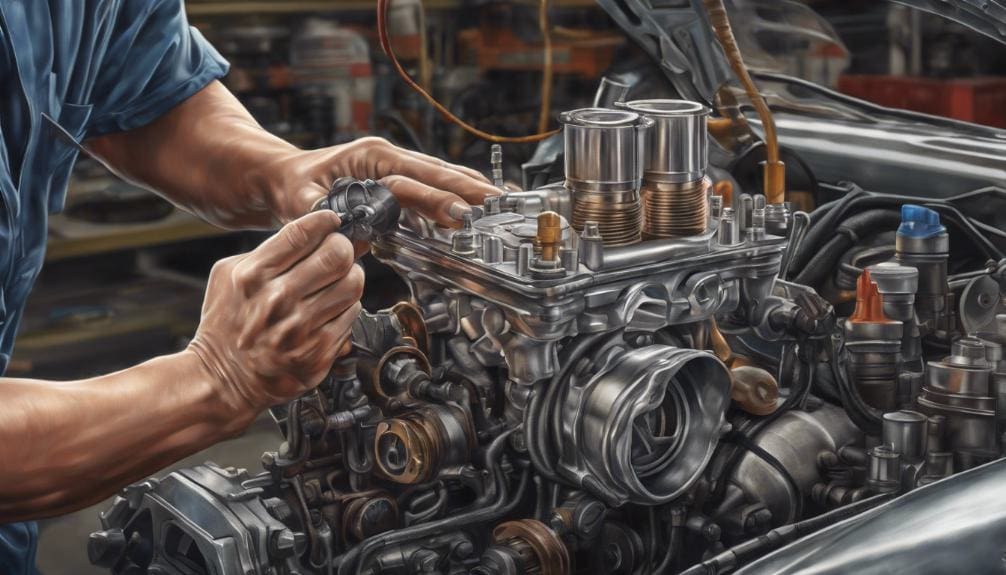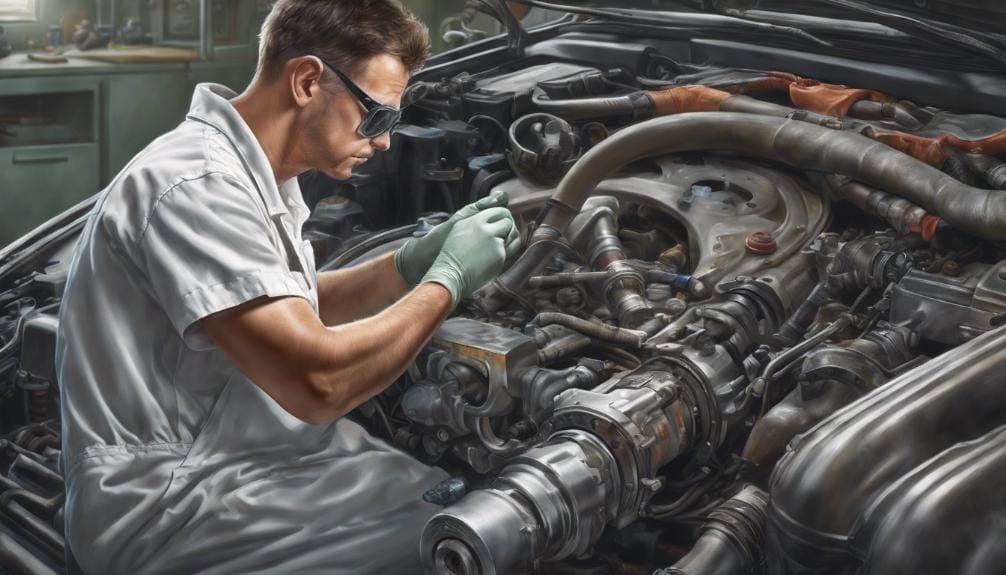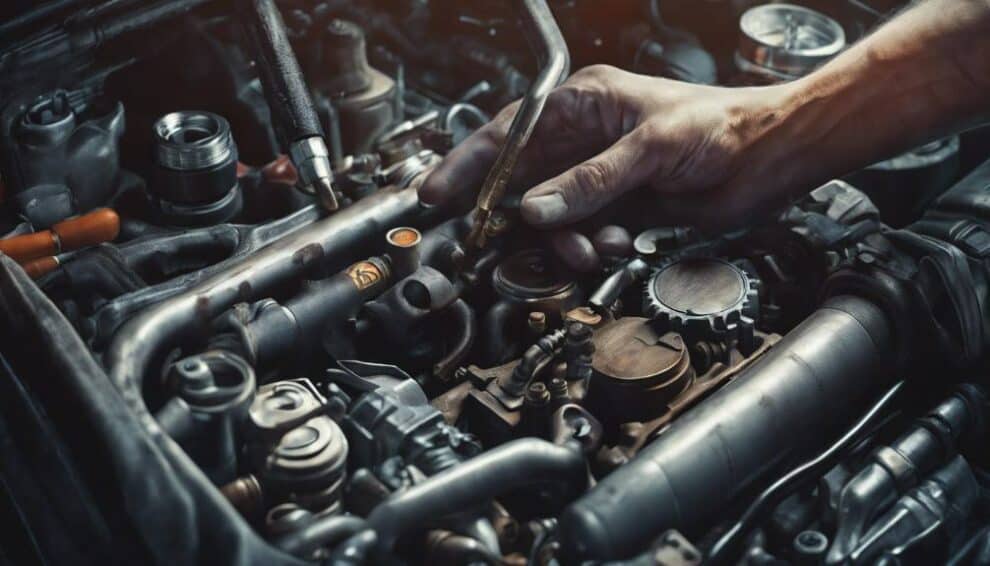To conquer the persistent P0505 system malfunction, a thorough exploration into idle control mastery is imperative. Tackling this issue demands a keen eye for detail and a systematic approach to troubleshooting.
With a blend of technical expertise and precision, unraveling the intricacies behind this error code reveals a path to restoring your vehicle’s peak performance.
Key Points
- Understand the P0505 error code implications on idle air control.
- Importance of maintaining idle air control valve for engine performance.
- Throttle body cleaning critical for preventing idle issues.
- Regular spark plug evaluation for combustion efficiency and reliability.
- Implement advanced diagnostic techniques for precise P0505 system resolution.
Understanding the P0505 Error Code

If you’ve ever encountered the P0505 error code, you know it signifies a problem with the idle air control system. Idle speed analysis becomes essential when dealing with this issue.
The engine performance optimization is directly affected by the idle air control system. Symptoms like low idle speed and rough engine running are common indicators of a P0505 error.
When this code appears, it’s important to focus on diagnosing and resolving the underlying causes promptly.
To tackle the P0505 error effectively, understanding how the idle air control system influences engine performance optimization is key. By analyzing the idle speed patterns, you can pinpoint irregularities that may lead to the error code.
Cleaning components like the throttle body and MAF sensor can often rectify the P0505 code. However, in some cases, the absence of an IAC valve in certain models can also contribute to triggering this error.
Importance of Idle Air Control Valve
The Idle Air Control Valve (IACV) is an essential component in regulating your engine’s idle speed by managing the airflow into the engine.
The significance of the Idle Air Control Valve (IACV) can’t be overstated when it comes to maintaining ideal engine performance. This essential component ensures that your engine idles smoothly and consistently.
A malfunctioning IACV can lead to issues such as rough idling, stalling, and overall poor engine performance. To prevent these problems, regular maintenance of the IACV is key.
By cleaning or replacing the IACV as needed, you can address potential idle control issues and even resolve the troublesome P0505 error code.
Proper maintenance of the IACV is crucial for ensuring the correct air-fuel mixture at idle, which in turn guarantees smooth engine operation and top fuel efficiency.
Remember, taking care of your Idle Air Control Valve (IACV) is crucial for keeping your engine running smoothly.
Throttle Body Inspection and Cleaning

When inspecting and cleaning your throttle body, it’s important to check for carbon buildup and dirt accumulation. Throttle body maintenance is vital for performance enhancement.
Over time, carbon deposits can accumulate on the throttle plate, affecting idle speed and throttle response. To clean the throttle body, you can use a throttle body cleaner and a soft brush.
By removing these deposits, you can improve air flow and engine efficiency.
Regular throttle body maintenance helps prevent idle issues and ensures your engine operates smoothly. Keeping the throttle body clean is a simple yet effective way to maintain your vehicle’s performance.
By incorporating throttle body inspection and cleaning into your routine maintenance schedule, you can prolong the life of your engine and avoid potential problems down the road.
Take the time to inspect and clean your throttle body regularly to keep your engine running at its best.
Spark Plug Evaluation and Replacement
Inspecting and cleaning your throttle body is crucial for excellent engine performance; similarly, evaluating and replacing spark plugs at recommended intervals is essential for maintaining combustion efficiency and overall reliability.
Proper spark plug maintenance is key to enhancing your vehicle’s performance. Here are some essential tips for spark plug evaluation and replacement:
- Check for Wear: Examine the spark plugs for signs of wear, such as eroded electrodes or worn-out insulators, which can lead to misfires and reduced engine efficiency.
- Look for Deposits: Inspect for any carbon deposits or oil buildup on the spark plugs, as these can hinder spark formation and combustion, affecting engine performance.
- Mind the Gaps: Ensure that the spark plug gaps are set to the manufacturer’s specifications, as improper gaps can cause ignition issues and decreased fuel efficiency.
- Choose Wisely: Select the appropriate spark plug type (copper, platinum, or iridium) based on your vehicle’s requirements to maximize durability and performance benefits.
Following these steps will help you maintain excellent combustion efficiency, improve engine performance, and ensure the reliability of your vehicle.
Checking the PCV System

By understanding the role of the PCV system, you can effectively diagnose and resolve idle control problems in your vehicle. The PCV system is essential for regulating the ventilation of gases from the engine crankcase.
A faulty PCV valve can lead to issues like high idle, rough idling, or oil leaks.
To guarantee proper engine function and emissions control, regular PCV maintenance is vital. One way to check the PCV system is through vacuum testing.
By connecting a vacuum gauge to the PCV valve or hose, you can assess if the system is operating correctly. If the vacuum levels are abnormal, it may indicate a problem with the PCV valve.
Inspect the valve for any signs of damage or clogging. Replace the PCV valve if necessary to prevent engine performance issues.
Understanding and maintaining the PCV system can have a significant impact on your vehicle’s idle control and overall performance.
Cleaning EGR Ports for Efficiency
To maintain peak engine performance and address idle control issues, consider cleaning the EGR ports for efficiency. Here are some key points to guide you through the EGR maintenance process and enhance engine efficiency:
- Prevent Rough Idling: Cleaning EGR ports promotes proper exhaust gas recirculation, preventing rough idling caused by clogs.
- Improve Fuel Efficiency: By maintaining clean EGR components, you can enhance fuel efficiency and reduce emissions, contributing to a greener environment.
- Prevent Carbon Buildup: Regularly cleaning the EGR valve and ports helps prevent carbon buildup, which can impede engine performance over time.
- Ensure Longevity: Proper maintenance of EGR components not only addresses drivability issues but also helps extend the life of your engine, saving you money on costly repairs in the long run.
Resealing Gaskets for Proper Sealing

For achieving peak engine performance, ensuring proper sealing by resealing gaskets is essential. Gasket maintenance tips are vital for maintaining airtight seals and preventing vacuum leaks.
When resealing gaskets, consider using Permatex or similar sealants to enhance the seal’s security.
Before resealing, it’s important to clean surfaces thoroughly to achieve excellent adhesion between the gasket and components.
Proper sealing techniques are explained to guide you in aligning components accurately by ensuring the correct orientation of gaskets.
Pay special attention to resealing plenum and plenum plate gaskets as this can prevent air leaks that may negatively impact engine performance.
What is the Relationship Between Injector Circuit Malfunctions and Idle Control System Malfunctions?
When solving injector circuit malfunctions, it’s important to consider the potential impact on the idle control system. Injector circuit malfunctions can disrupt fuel delivery, affecting idle speed and stability. Furthermore, idle control system malfunctions can exacerbate injector circuit issues, leading to erratic idling and poor engine performance.
Addressing Coolant System Concerns
After diagnosing a severe vacuum leak at the plenum, Acura took necessary measures to address the coolant system concerns. Here are some key points to keep in mind:
- Coolant Flow: Guarantee proper circulation of coolant by checking for any blockages in the system that may impede flow.
- Hose Temperature: Monitor the temperature of the top and bottom hoses to identify any significant variations that could indicate a problem.
- Check for Air Pockets: Burp the coolant system to remove any trapped air, which can cause issues with proper coolant circulation and temperature regulation.
- Replace Faulty Components: If the engine coolant temperature sensor is faulty, contemplate replacing it to ensure accurate temperature readings and peak engine performance.
Precision in Diagnosis and Repair

Achieving precision in diagnosing and repairing the P0505 system malfunction demands careful attention to detail and a systematic approach.
When tackling this issue, utilizing advanced diagnostic techniques is essential to accurately pinpoint the root cause affecting idle speed and engine performance.
Diagnostic tools play a critical role in this process by aiding in the identification of specific faults within the system.
To guarantee an effective repair, thorough repair strategies must be employed to address the diagnosed issues directly.
By following a systematic approach, you can streamline the diagnosis and repair process, leading to a successful resolution of the P0505 system malfunction.
Remember, precision in diagnosis involves identifying the specific root causes of the problem, while precision in repair ensures that the underlying issues are adequately resolved.
Troubleshooting Root Causes Efficiently
Efficiently troubleshoot root causes by analyzing symptoms and conducting thorough inspections of key components. To resolve the P0505 system malfunction, follow these steps:
- Sensor recalibration: Use diagnostic tools to recalibrate sensors like the MAF and throttle body sensors, guaranteeing accurate readings for proper engine function.
- Voltage analysis: Perform voltage analysis on electrical connections related to the idle control system to identify any irregularities that could be causing the P0505 error code.
- Thorough component inspection: Inspect the IAC valve, throttle body, and MAF sensor for dirt or damage that may be triggering the P0505 issue.
- Check for loose connections: Verify all electrical connections in the idle control system are secure and free of corrosion, as loose connections can lead to faulty readings and trigger the P0505 error code.
As an Amazon Associate we earn from qualifying purchases.










